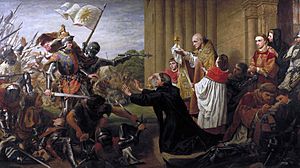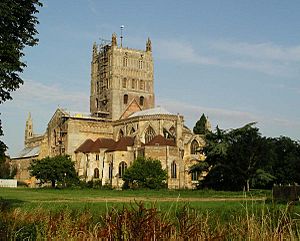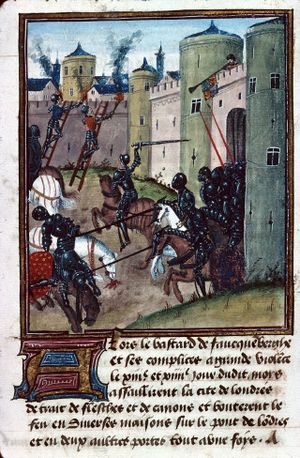Battle of Tewkesbury facts for kids
Quick facts for kids Battle of Tewkesbury |
|||||||
|---|---|---|---|---|---|---|---|
| Part of the Wars of the Roses | |||||||
 The battle depicted in a Ghent manuscript |
|||||||
|
|||||||
| Belligerents | |||||||
| Commanders and leaders | |||||||
| Strength | |||||||
| 5,000–6,000 men | Approx. 6,000 men | ||||||
| Casualties and losses | |||||||
| unknown | 2,000 Prince Edward † |
||||||
The Battle of Tewkesbury happened on 4 May 1471. It was one of the most important battles in the Wars of the Roses in England. The House of Lancaster's army was completely defeated. They were fighting against the House of York's army, led by King Edward IV.
During the battle, the Lancastrian heir to the throne, Edward, Prince of Wales, was killed. Many other important Lancastrian nobles also died or were executed. The Lancastrian king, Henry VI of England, was a prisoner in the Tower of London. He died shortly after the battle. The Battle of Tewkesbury brought peace to England until Edward IV died in 1483.
Contents
What were the Wars of the Roses?
The "Wars of the Roses" was a name given to the fights between two powerful families. These families were the House of Lancaster and the House of York. They both wanted to control England and its throne. Their informal symbols were a red rose for Lancaster and a white rose for York.
The fighting had been going on since the late 1450s. In 1461, Edward, Earl of March, who was a Yorkist, became King Edward IV. He defeated the Lancastrian King Henry VI's supporters at the Battle of Towton. After this, Henry VI was captured and put in prison in 1465. His wife, Margaret of Anjou, and their son, Edward of Westminster, had to leave England. For a while, Edward IV seemed safe on the throne.
Edward IV had won thanks to his cousin, the powerful Earl of Warwick. But they later disagreed. Edward married Elizabeth Woodville in secret, which Warwick didn't like. Edward also gave important jobs to Elizabeth's family. This made Warwick angry. Warwick then joined with Edward IV's brother, George Plantagenet, 1st Duke of Clarence. They tried to take over the throne. Edward was briefly imprisoned, but he soon got his power back. Warwick and Clarence had to escape to France.
Henry VI Returns to Power
Warwick had no hope of making peace with King Edward. So, he decided to bring King Henry VI back to the throne. Louis XI of France helped Warwick with money and soldiers. But first, Margaret of Anjou, Henry VI's wife, had to agree. Warwick and Margaret used to be enemies. But with help from Louis XI, they finally agreed to work together.
Warwick landed in England on 13 September 1470. He was joined by Clarence and other Lancastrian nobles. King Edward IV went south to fight Warwick. But then he found out that Warwick's brother, Montagu, had also joined Warwick. Edward had to flee to Flanders, which was part of Burgundy. He went with his youngest brother, Richard of Gloucester, and a few loyal friends.
In London, Warwick freed King Henry VI from prison. He put Henry back in charge at Westminster palace. But Warwick's power was still not strong. His plans to fight Burgundy would hurt England's trade. Also, Clarence felt left out of Warwick's plans. Clarence secretly made up with his brother, King Edward.
Edward Returns and Warwick Dies
The Duke of Burgundy, Charles, was now worried about England and France working together. So, he gave King Edward IV money and ships. Edward sailed from Flushing on 11 March 1471 with 36 ships and 1,200 men. He landed in England at Ravenspurn. This was the same place where Henry Bolingbroke had landed years before to claim the throne.
At first, Edward's landing was difficult. His ships were spread out by bad weather. But as he marched south, he gathered more supporters. Soon, he was strong enough to declare himself King again. The Earl of Warwick asked Queen Margaret to come to England with more soldiers. Warwick was at Coventry, trying to stop Edward from reaching London.
But Edward knew that Clarence was ready to switch sides again. Edward quickly marched west and met Clarence's men. Clarence asked Warwick to give up, but Warwick refused. Edward's army then marched quickly to London. Warwick and Montagu followed him. London was supposed to be defended by the Duke of Somerset, but he wasn't there. So, the city let Edward in easily. Poor King Henry VI was sent back to the Tower of London.
Edward then turned to face Warwick's army. On 14 April, they fought at the Battle of Barnet. It was a very foggy battle. Some of Warwick's soldiers accidentally attacked each other. Warwick's army fell apart and was defeated. Montagu died in the battle, and Warwick was killed trying to escape.
The March to Tewkesbury
Queen Margaret finally sailed to England on 24 March. Storms made her ships turn back several times. She and Prince Edward landed at Weymouth on the same day the Battle of Barnet was fought. The Duke of Somerset told her about the terrible defeat at Barnet. Margaret wanted to go back to France. But Prince Edward convinced her to keep fighting.
Somerset and the Earl of Devon had already gathered an army for Lancaster. Their best plan was to march north. They wanted to join forces with other Lancastrians in Wales, led by Jasper Tudor. Other Lancastrian forces were also planning to attack elsewhere.
King Edward learned about Margaret's landing two days later. He quickly gathered his army at Windsor. Margaret's army was trying to reach Wales. They marched to Bath and then to Bristol for supplies. Edward's army followed them closely.
On 2 May, the Lancastrians made a clever move. They pretended to go towards Little Sodbury. Edward's scouts fought them there. Edward thought the Lancastrians were ready to fight. So, he stopped his army to rest. But the Lancastrians secretly marched north during the night. They passed very close to Edward's army. By the morning of 2 May, they had reached Berkeley Castle. They were 15 miles ahead of Edward.
King Edward realized that the Lancastrians wanted to cross the River Severn into Wales. The closest place to cross was at Gloucester. Edward sent urgent messages to the governor, Sir Richard Beauchamp. He told him to close the city gates to Margaret's army. When Margaret arrived on 3 May, Beauchamp refused to let her pass. She knew she didn't have enough time to attack the city.
So, her army marched another 10 miles to Tewkesbury. They hoped to reach the next bridge at Upton-upon-Severn. Edward's army marched 31 miles that day. It was a very hot day, and both armies were exhausted. The Lancastrians had to leave some of their cannons behind.
At Tewkesbury, the tired Lancastrians stopped for the night. Most of their soldiers were on foot and needed rest. Edward's army was mostly mounted. They could move faster. Edward's scouts told him where Margaret's army was. Edward pushed his army to march another 6 miles. They stopped 3 miles from the Lancastrians. The Lancastrians knew they couldn't run any further. They would have to fight.
The Battle of Tewkesbury
Lancastrian Battle Lines
On the morning of 4 May, the Lancastrians set up their defense. They were about a mile south of Tewkesbury. Behind them were the River Avon and the Severn. Tewkesbury Abbey was right behind their center. The ground in front of them was difficult to cross. It had hedges, woods, and ditches.
The Lancastrian army had about 6,000 soldiers. This was only a few hundred more than the Yorkists. Their army was divided into three groups. The right group was led by the Duke of Somerset. A stream, the Colnbrook, ran through his position. This made the ground even harder to cross.
The middle group was led by Lord Wenlock. Prince Edward was with this group. Prince Edward was 17 years old. He had seen battles before but had no real command experience. The left group was led by the Earl of Devon. His group and part of the center were on a low hill called the "Gastons." A small river, the Swilgate, protected Devon's left side.
Edward's Plan
The Yorkist army had about 5,000 to 6,000 men. King Edward also divided his army into three groups.
Edward's first group was led by his youngest brother, Richard, Duke of Gloucester. Richard was only 18 but was already a skilled commander. King Edward himself led the main group. Clarence was also in this group. Edward was 29 and a very strong soldier. His friend, Lord Hastings, led the last group. He was also an experienced commander.
Edward made one very important move. To the left of his army was a thick wood. He was worried that hidden Lancastrians might attack from there. So, he sent 200 mounted spearmen to hide in the woods. They would stop any Lancastrian attack or join the fight if needed. Then, Edward's army moved forward to attack.
The Fight Begins

As King Edward's army moved, they found the ground very difficult. It was hard to attack in an organized way. But the Yorkist archers and cannons fired many arrows and shots at the Lancastrians. The Yorkists had more cannons and used them better.
The Duke of Somerset decided to attack Edward's left side. He led his men through the difficult lanes. Edward's men were surprised but fought back bravely. They pushed back Somerset's attack. At a key moment, the 200 spearmen Edward had hidden in the woods attacked Somerset from behind. Gloucester's group also joined the fight.
Somerset's group was completely defeated. The surviving soldiers tried to run away across the Severn River. Most were killed as they fled. The field leading to the river is still called "Bloody Meadow" today. Somerset rode to Lord Wenlock, who led the center. He demanded to know why Wenlock had not helped him. Legend says Somerset killed Wenlock with a battleaxe before running to the Abbey for safety.
The rest of the Lancastrian army lost hope and tried to escape. But the Swilgate River became a deadly barrier. Many soldiers drowned or were killed by the Yorkists.
After the Battle
Many important Lancastrians died in the battle. These included Somerset's younger brother and the Earl of Devon. Prince Edward was found by some of Clarence's men. He was killed, even though he begged for his life.
Many other Lancastrian nobles tried to find safety in Tewkesbury Abbey. King Edward went to the Abbey shortly after the battle. He allowed Prince Edward and others killed in battle to be buried there. This was unusual, as traitors were usually treated very harshly. However, two days later, Somerset and other leaders were dragged out of the Abbey. Gloucester and the Duke of Norfolk ordered them to be executed after quick trials. The Abbey had to be blessed again because of the violence that happened inside it.
A few days later, Queen Margaret sent a message to Edward. She said she would do whatever he commanded.
Fauconberg's Attack on London
Edward could not rest after the battle. Other Lancastrian forces were still active. The most dangerous was led by the Bastard of Fauconberg. He had landed at Sandwich and gathered a large army. This army may have had as many as 17,000 men.
On 14 May, Fauconberg attacked London from the south. His men burned part of Southwark, but they were stopped at London Bridge. The next day, they attacked other parts of the city. The soldiers defending the Tower of London, led by Earl Rivers, fought them off. The citizens also helped defend their homes.
If Fauconberg had captured London, he might have captured Edward's wife and children. He also might have freed King Henry from the Tower. But when he heard Edward's army was coming, he retreated. He seemed to lose heart after hearing about Tewkesbury and Prince Edward's death. He later surrendered and was executed five months later.
The End of the Lancastrian Royal Family
Edward returned to London in triumph on 21 May. Queen Margaret was with him as a prisoner. King Henry VI died in the Tower of London that night. Some accounts say Richard of Gloucester was involved in his death. The public was told Henry died "of pure displeasure and melancholy." But few people believed this.
Gloucester later married Anne Neville. She was Warwick's younger daughter and Prince Edward's widow.
With the deaths of Somerset and his brother, the House of Beaufort family was almost gone. Only Lady Margaret Beaufort and her son Henry Tudor remained. Henry Tudor later became King Henry VII. Henry escaped from Wales with his uncle, Jasper Tudor. He stayed in exile in Brittany for the rest of Edward's reign.
Reliving the Battle Today
Every year, the Battle of Tewkesbury is re-enacted. This happens on the second weekend in July at the Tewkesbury Medieval Festival. This event started in 1984. It is one of the biggest events of its kind in Europe. People from all over the world come to see it.
Battle Monument
The Tewkesbury Battlefield Society built a monument to the battle. It has two sculptures, 5 meters (16 feet) high. One is a winning knight on a horse, and the other is a defeated horse. The artwork is called Arrivall. It was made by Phil Bews from oak wood. It was dedicated on the battle's anniversary in 2014.
See also
 In Spanish: Batalla de Tewkesbury para niños
In Spanish: Batalla de Tewkesbury para niños




